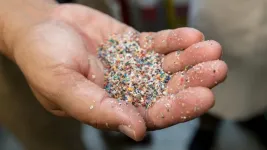(Press-News.org) UNIVERSITY PARK, Pa. — Using a novel method to detect microbial activity in biological soil crusts, or biocrusts, after they are wetted, a Penn State-led research team in a new study uncovered clues that will lead to a better understanding of the role microbes play in forming a living skin over many semi-arid ecosystems around the world. The tiny organisms — and the microbiomes they create — are threatened by climate change.
The researchers published their findings in Frontiers of Microbiology.
“Biocrusts currently cover approximately 12% of Earth’s terrestrial surface, and we expect them to decrease by about 25% to 40% within 65 years due to climate change and land-use intensification,” said team leader Estelle Couradeau, Penn State assistant professor of soils and environmental microbiology. “We hope this work can pave the way to understanding the microbial functions supporting biocrust resilience to the rapidly changing climate patterns and more frequent droughts.”
Biological soil crusts are assemblages of organisms that form a perennial, well-organized surface layer in soils. They are widespread, occurring on all of the continents wherever a shortage of water limits the growth of common plants, allowing light to reach bare soil. But there is still sufficient water to support the growth of microorganisms that perform valuable ecosystem services such as taking carbon and nitrogen from the air and fixing them in the soil, recycling nutrients and holding soil particles together, which helps prevent dust.
That soil-stabilizing function — which reduces erosion by providing the means for soil to clump and not break down into dust — is extremely important, according to Couradeau. Her research group, now in Penn State’s College of Agricultural Sciences, has been intensively studying biocrusts for a decade.
“Most dust is generated in drylands, and studies suggest that the presence of biocrusts in drylands greatly reduce the amount of dust that would otherwise make its way into the atmosphere,” she said. “We think losing biocrusts would cause a 5% to 15% increase in global dust emission and deposition — which would affect the climate, environment and human health.”
In the semi-arid regions where biocrusts exist, the organisms — tiny mosses, lichens, green algae, cyanobacteria, other bacteria and fungi — may experience just a few rain or snow events a year, explained Ryan Trexler, a doctoral degree candidate in the Intercollege Graduate Degree Program in ecology and in biogeochemistry, who spearheaded the research.
“When the soil is dry, for the most part, the microbes in the soil are dormant, not doing much,” he said. “But as soon as they sense water, they're resuscitated very quickly, within seconds to minutes. And they are actively making chlorophyll and fixing carbon and nitrogen until the soil is dry again — and then the microbes go dormant again. They go through cycles of activity every time it rains.”
To study biocrusts, the researchers took samples from three plots of undisturbed, cyanobacteria-dominated biocrusts located on the Colorado Plateau near Moab, Utah. Biocrust samples were taken in fall following rain that wetted the soil sufficiently to activate the microbes. The samples were subsequently dried and stored in the dark and then rewetted much later in the research.
“We sampled what we call ‘a cold desert,’ because it’s very arid, but in the winter, it sometimes snows,” Trexler said. “So, it's not as hot as many other arid places, but still plants cannot thrive there because there's not enough water. And so, the only community that we find in soils at the site are microbial.”
To determine which microorganisms are active within soil communities, the researchers coupled bioorthogonal non-canonical amino acid tagging — known as BONCAT — with fluorescence-activated cell sorting. BONCAT is a powerful tool for tracking protein synthesis on the level of single cells within communities and whole organisms, while fluorescence-activated cell sorting sorts cells based on whether they are producing new proteins.
The researchers combined these processes with shotgun metagenomic sequencing, which allowed them to comprehensively sample all genes in all organisms present in biocrust samples. They applied this method to profile the diversity and potential functional capabilities of both active and inactive microorganisms in a biocrust community after being resuscitated by a simulated rain event. The researchers found that their novel approach can discern active and inactive microorganisms in wetted biocrusts.
The active and inactive components of the biocrust community differed in species richness and composition at both four hours and 21 hours after the wetting event, the researchers reported.
Contributing to the research were Marc Van Goethem, Lawrence Berkeley National Laboratory, and King Abdullah University of Science and Technology, Jeddah, Saudi Arabia; Danielle Goudeau, Nandita Nath, Trent Northen and Rex Malmstrom, Lawrence Berkeley National Laboratory, U.S. Department of Energy Joint Genome Institute.
The U.S. Department of Energy supported this research.
END
Soil microbiome, Earth’s ‘living skin’ under threat from climate change
Novel approach to measuring microbe activity in wetted soil leads to better understanding of vulnerability, researchers report
2023-08-11
ELSE PRESS RELEASES FROM THIS DATE:
Zentropy and the art of creating new ferroelectric materials
2023-08-11
UNIVERSITY PARK, Pa. — Systems in the Universe trend toward disorder, with only applied energy keeping the chaos at bay. The concept is called entropy, and examples can be found everywhere: ice melting, campfire burning, water boiling. Zentropy theory, however, adds another level to the mix.
A team led by Zi-Kui Liu, the Dorothy Pate Enright Professor of Materials Science and Engineering at Penn State, developed the theory. The “Z” in zentropy stands for the German word Zustandssumm, meaning ‘‘sum over states” of entropy. Alternatively, Liu said, zentropy may be considered as a play on the term “zen” ...
Ribbons of graphene push the material’s potential
2023-08-11
Think you know everything about a material? Try giving it a twist—literally. That’s the main idea of an emerging field in condensed matter physics called “twistronics,” which has researchers drastically changing the properties of 2D materials, like graphene, with subtle changes—as small as going from a 1.1° to 1.2°—in the angle between stacked layers. Twisted layers of graphene, for example, have been shown to behave in ways that single sheets have not, including acting like magnets, like electrical superconductors, or like a superconductor’s opposite, insulators, all due to small changes in the twist angle between sheets.
In theory, you ...
New recycling process could find markets for ‘junk’ plastic waste
2023-08-11
MADISON – Although many Americans dutifully deposit their plastic trash into the appropriate bins each week, many of those materials, including flexible films, multilayer materials and a lot of colored plastics, are not recyclable using conventional mechanical recycling methods. In the end, only about 9 percent of plastic in the United States is ever reused, often in low-value products. With a new technique, however, University of Wisconsin–Madison chemical engineers are turning low-value waste plastic into high-value ...
The Israeli Override Clause: a threat to the health in all policies approach
2023-08-11
On July 24, 2023, Israel's Parliament sanctioned a substantial amendment to the Basic Law, prompting apprehensions regarding power equilibrium and its potential influence on public well-being. In response, a coalition of prominent Israeli and global public health experts has united to dissect the profound ramifications of this revision in an article titled “Israel's Judicial Overhaul: A Threat to the Health in All Policies Approach” featured in The Lancet.
The amendment, restricts ...
Indicator of PFAS found in some — but not all — period products
2023-08-11
SAN FRANCISCO, Aug. 10, 2023 — Period products come in a variety of styles — liners, pads, tampons, cups and underwear — to help people feel comfortable during a menstrual bleed. But their labels don’t usually list the ingredients, so consumers don’t know what’s in their product of choice. Now, researchers have analyzed over 100 period products for fluorinated compounds, an indicator of potentially harmful per- and polyfluoroalkyl substances, or PFAS. Their results show that while PFAS are absent from many products, ...
Exercise training and yoga can help improve lung function in adults with asthma
2023-08-11
Yoga and breathing control practices, in combination with aerobic training, are particularly key exercises for asthmatic people seeking to improve their lung function, a new peer-reviewed study suggests.
The research which is published today in the journal Annals of Medicine highlights the importance of integrating appropriate exercise training into asthma management plans.
The findings demonstrate just how effective specific types of exercise training can be to enhance lung function for those with adults, explains ...
Fat burning during exercise varies widely between individuals
2023-08-11
New York, NY [August 10, 2023]—The best heart rate for burning fat differs for each individual and often does not align with the “fat burning zone” on commercial exercise machines, Icahn School of Medicine at Mount Sinai researchers report.
Instead, the researchers said, clinical exercise testing—a diagnostic procedure to measure a person’s physiological response to exercise—may be a more useful tool to help individuals achieve intended fat loss goals. The study, which used a machine learning-based modeling approach, was published online today in Nutrition, Metabolism and Cardiovascular Disease.
“People with a goal of weight or fat loss may ...
The health impact of climate change is not adequately recorded: study
2023-08-11
A Monash University-led study has proposed a solution for the urgent need to capture real-time data on the impact of climate change-related events on human health, healthcare workforces, and healthcare systems at the point of care.
As the global community faces growing climate challenges, the study calls for action, collaboration, and innovation to safeguard human health and wellbeing in the face of environmental crises.
Published in the Journal of the American Medical Informatics Association, it highlighted key climate ...
New research shows genetic mutation known for Alzheimer’s disease is associated with higher fertility in women
2023-08-10
(Santa Barbara, Calif.) — Previous research has revealed that the Apolipoprotein-ε4 (APOE-ε4) allele increases the risk for a variety of diseases in aging populations, specifically Alzheimer’s and cardiovascular disease. And yet, despite the negative effects of this genetic variant, it remains prevalent in approximately 20% of the human population. In a quest to determine how this negative allele is surviving natural selection, a group of researchers have discovered that the APOE-ε4 allele is associated with higher fertility in women.
In a new paper released in Science Advances, researchers including UC Santa ...
Trinity research looks to Latin America for clues on healthy brain ageing
2023-08-10
Researchers at Trinity College Dublin study the factors influencing healthy brain ageing in Latin American and Caribbean (LAC) countries and find the lessons learned there, can also be applied to home.
Ageing is not a uniform process across the globe. Most research into cognitive and functional ageing has been conducted in the US and Europe, in high-income settings. Researchers from the Global Brain Health Institute (GBHI) at Trinity College are filling the knowledge gap that exists for Latin American populations on the factors ...
LAST 30 PRESS RELEASES:
Heart-brain connection: international study reveals the role of the vagus nerve in keeping the heart young
Researchers identify Rb1 as a predictive biomarker for a new therapeutic strategy in some breast cancers
Survey reveals ethical gaps slowing AI adoption in pediatric surgery
Stimulant ADHD medications work differently than thought
AI overestimates how smart people are, according to HSE economists
HSE researchers create genome-wide map of quadruplexes
Scientists boost cell "powerhouses" to burn more calories
Automatic label checking: The missing step in making reliable medical AI
Low daily alcohol intake linked to 50% heightened mouth cancer risk in India
American Meteorological Society announces Rick Spinrad as 2026 President-Elect
Biomass-based carbon capture spotlighted in newly released global climate webinar recording
Illuminating invisible nano pollutants: advanced bioimaging tracks the full journey of emerging nanoscale contaminants in living systems
How does age affect recovery from spinal cord injury?
Novel AI tool offers prognosis for patients with head and neck cancer
Fathers’ microplastic exposure tied to their children’s metabolic problems
Research validates laboratory model for studying high-grade serous ovarian cancer
SIR 2026 delivers transformative breakthroughs in minimally invasive medicine to improve patient care
Stem Cell Reports most downloaded papers of 2025 highlight the breadth and impact of stem cell research
Oxford-led study estimates NHS spends around 3% of its primary and secondary care budget on the health impacts of heat and cold in England
A researcher’s long quest leads to a smart composite breakthrough
Urban wild bees act as “microbial sensors” of city health.
New study finds where you live affects recovery after a hip fracture
Forecasting the impact of fully automated vehicle adoption on US road traffic injuries
Alcohol-related hospitalizations from 2016 to 2022
Semaglutide and hospitalizations in patients with obesity and established cardiovascular disease
Researchers ‘listen in’ to embryo-mother interactions during implantation using a culture system replicating the womb lining
How changing your diet could help save the world
How to make AI truly scalable and reliable for real-time traffic assignment?
Beyond fragmented markets: A new framework for efficient and stable ride-pooling
Can shape priors make road perception more reliable for autonomous driving?
[Press-News.org] Soil microbiome, Earth’s ‘living skin’ under threat from climate changeNovel approach to measuring microbe activity in wetted soil leads to better understanding of vulnerability, researchers report







